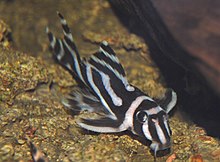Clearwater river (river type)
A clearwater river is classified based on its chemistry,
The main clearwater rivers are South American and have their source in the
Amazonian rivers fall into three main categories: clearwater, blackwater and whitewater. This classification system was first proposed by Alfred Russel Wallace in 1853 based on water colour, but the types were more clearly defined according to chemistry and physics by Harald Sioli from the 1950s to the 1980s.[2][8][9] Although many Amazonian rivers fall clearly into one of these categories, others show a mix of characteristics and may vary depending on season and flood levels.[9][10]
Location

The main clearwater rivers are South American and have their source in the
Outside South America the classification is not commonly used, but rivers with clearwater characteristics are found elsewhere, such as the upper
Chemistry and sediments

In South America, clearwater rivers typically have their source and flow through regions with sandy soils and
Sand and kaolinite are the typical sediments transported by clearwater rivers, similar to blackwater, but unlike whitewater that also transports high levels of illite and montmorillonite, resulting in a significantly higher fertility of places influenced by the latter river type.[8] Nevertheless, although clearwater rivers can have extremely low nutrient levels similar to blackwater, some such as the Tapajós, Xingu and Tocantins have nutrient levels that are intermediate between black and whitewater.[8] The exact chemistry of clearwater rivers varies,[8] but it is often very similar to rainwater, low in major nutrients with sodium as the relatively dominating chemical.[14]
The water is typically neutral to slightly acidic,[4][14] but the pH can range between 4.5[8] and 8.[2] In the Amazon basin, clearwater rivers flowing through regions with sediments of Tertiary age are typically highly acidic, while those flowing through sediments of Carboniferous age are closer to neutral or slightly basic.[8]
As suggested by the name, clearwater rivers are highly transparent with a typical visibility of 1.5–4 m (5–13 ft).[15] There can be large variations, even within a single river, depending on season or heavy rains.[8]
| Juruá River (typical whitewater) | Tapajós River (typical clearwater)
|
Tefé River (typical blackwater) | |
|---|---|---|---|
| pH | 7.27 | 6.56 | 5.03 |
Electric conductivity (μS/cm)
|
191.14 | 14.33 | 7.36 |
| Total suspended solids (mg/L) | 51.42 | 10.56 | 7.90 |
| Ca (mg/L) | 32.55 | 0.52 | 0.71 |
| Mg (mg/L) | 4.42 | 0.26 | 0.22 |
Na (mg/L)
|
10.19 | 1.50 | 0.40 |
K (mg/L)
|
1.98 | 0.93 | 1.41 |
| Total P (mg/L) | 0.080 | 0.010 | 0.033 |
| CO 3 (mg/L) |
106.14 | 8.80 | 6.86 |
| NO 3 (mg/L) |
0.031 | 0.040 | 0.014 |
| NH 4 (mg/L) |
0.062 | 0.19 | 0.13 |
| Total N (mg/L) | 0.39 | 0.35 | 0.24 |
| SO 4 (mg/L) |
2.56 | 0.30 | 4.20 |
| Colour (mg/Pt/L) | 41.61 | 4.02 | 54.90 |
| Si (mg/L) | 5.78 | 5.25 | 0.33 |
| Cl (mg/L) | 4.75 | 0.53 | 0.85 |
Ecology

The difference in chemistry and visibility between the various black, white and clearwater rivers result in distinct differences in flora and fauna.[2] Although there is considerable overlap in the fauna found in the different river types, there are also many species found only in one of them.[18][19][20] Many blackwater and clearwater species are restricted to relatively small parts of the Amazon, as different blackwater and clearwater systems are separated (and therefore isolated) by large whitewater sections.[2][19] These "barriers" are considered a main force in allopatric speciation in the Amazon basin.[2]
Many species of fish, which often are
References
- ^ PMID 27662358.
- ^ a b c d e f g h i Duncan, W.P.; M.N. Fernandes (2010). "Physicochemical characterization of the white, black, and clearwater rivers of the Amazon Basin and its implications on the distribution of freshwater stingrays (Chondrichthyes, Potamotrygonidae)". PanamJAS. 5 (3): 454–464.
- ^ ISBN 0-8120-4669-2.
- ^ ISBN 978-0-691-17074-9.
- ^ S2CID 36001397.
- ^ .
- ^ ISBN 978-0-12-088449-0.
- ^ ISBN 978-94-009-6544-7.
- ^ a b c Ríos-Villamizar, E.A.; M.T.F. Piedade; J.G. da Costa; J.M. Adeney; J. Junk (2013). "Chemistry of different Amazonian water types for river classification: A preliminary review".
- .
- S2CID 55234507.
- ^ "Waters". Amazon Waters. Retrieved 10 October 2017.
- .
- ^ a b "Clearwater Rivers". Amazon Waters. Retrieved 1 October 2017.
- ISBN 978-90-481-8520-7.
- ^ "Habitat". zebrapleco.com. Retrieved 10 October 2017.
- ^ a b Hyland, T.; M.H.S. Perez. "Race against time". Exel Magazine. Retrieved 10 October 2017.
- S2CID 25361090.
- ^ ISBN 91-86510-04-5.
- S2CID 84919041.
- PMID 27701358.
- ISBN 0-04-581031-1.
